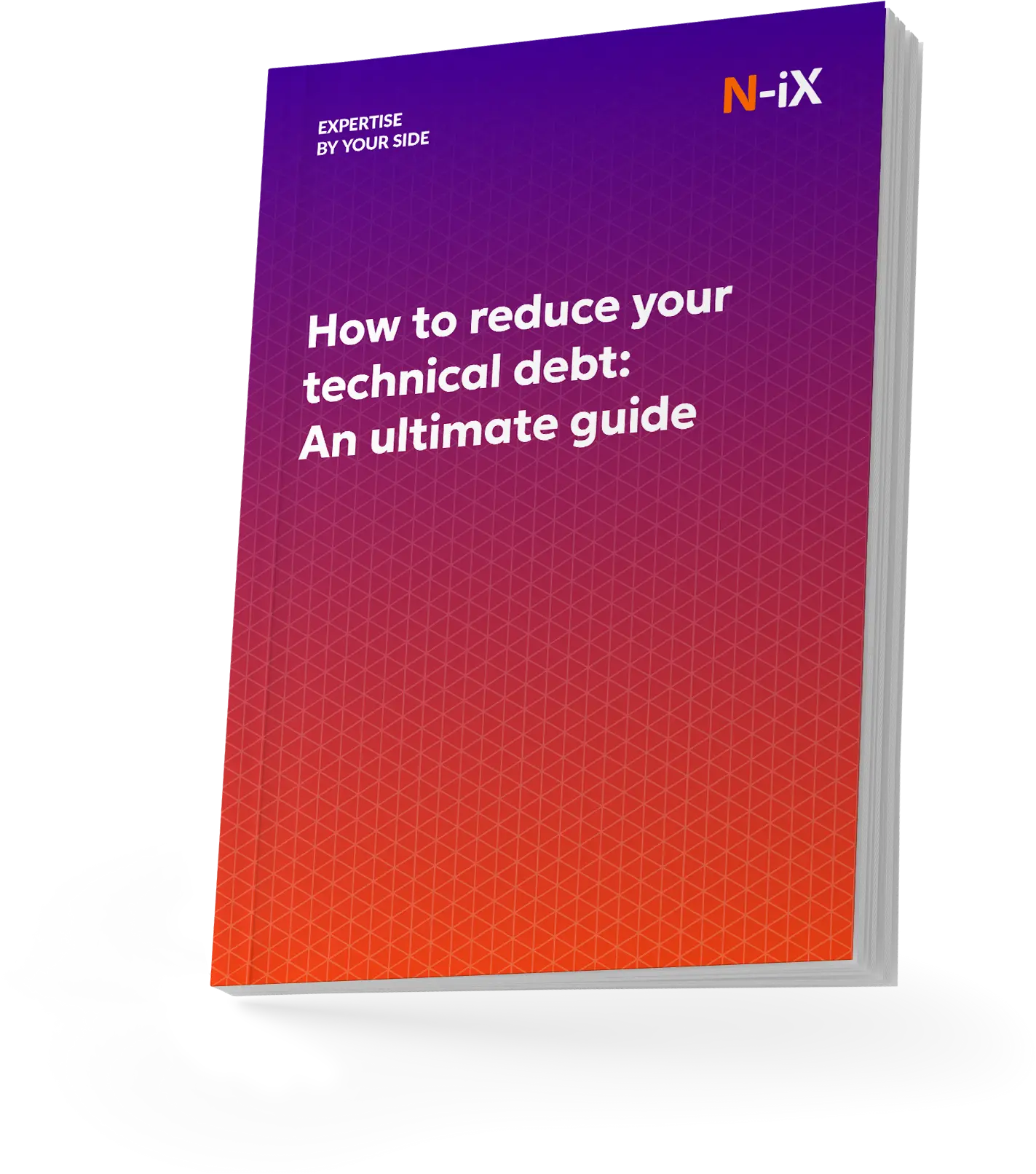The vFunction report states that nearly 79% of application modernization projects fail, leading to significant financial losses. Modernization efforts cost around $1.5M, and these setbacks highlight a critical issue for organizations: the need for an effective application modernization strategy. On the bright side, businesses that implement a robust strategy can reap the benefits of modernization, including reduced operational costs, enhanced performance, and improved customer experience.
So, what crucial steps should you consider when developing a custom app modernization strategy for your business? And how do you choose the right application modernization approach that can pave the way for a seamless upgrade from the technical perspective? Let's find out.
Business perspective: How to develop an effective application modernization strategy?
The strategy for application modernization can be approached from two perspectives: business and technical. From a business standpoint, it's an action plan that focuses on transforming legacy applications to reach business goals, improve operational efficiency, and drive growth.

In addition to supporting business objectives, a modernization strategy should incorporate robust change management practices to ensure a smooth transition and ease user adaptation. Here are seven key steps for executives that will help you develop an effective app modernization strategy:
1. Define the desired state of your application
Developing an effective application modernization strategy begins with outlining your application's desired state and aligning your modernization efforts with your business objectives. First, identify your primary goals for app modernization, whether it's business acceleration, expanding to new markets, or resolving issues where the current system no longer supports new processes or technologies.
Now it's time to answer the question: how would application modernization help my business achieve these goals? For instance, if you aim to reach new markets, your desired application might need better scalability and multi-language support. By modernizing your application, you can ensure it can handle increased traffic and provide a localized experience to users in different regions. So, at this stage, your essential task is to determine the desired outcomes of your app modernization, such as performance improvements, solution scalability, or other factors, and define what value they would bring to your business.
2. Assess the legacy system
In this step, thoroughly assess your existing legacy applications to understand their current state, limitations, and strengths. Not all applications require a rip and replace approach—some features of your software might already be effective. Once you have defined which applications or application components should be modernized, try to prioritize them. Is there a component causing the most issues, or perhaps one that would significantly benefit from modernization? Identifying these high-impact areas will help you understand which of them are up for immediate redevelopment.
Reduce your technical debt—download the guide now!


Success!

3. Gather the users' feedback
User experience is pivotal if we speak about upgrading your product since it provides first-hand insights into the application's performance and areas needing improvement. We recommend conducting surveys or interviews with internal (your employees) or external users (customers) as a part of your application modernization strategy. Ask the end users questions about their experiences with your application, focusing on aspects such as:
- Usability. How easy is it for users to navigate and use the application?
- Performance. Are there any performance issues, such as slow loading times or crashes?
- Functionality. Are there any missing features or functionalities that users need?
Consider these answers while defining your application's desired state. That way, modernization would be a win-win for both your users and your business.
4. Evaluate the impact on availability and security
It's critical to prepare an application modernization strategy considering all the potential risks. First, you focus on identifying the most critical applications and consider how to minimize their downtime during the transitional period. This will avoid business operations disruption or user dissatisfaction.
In addition, gauge the security risks associated with your legacy system and those that might arise during and after the modernization process. Data security is paramount for most organizations, especially in the healthcare and financial industries; therefore, data breaches can result in significant financial and reputational damage. Businesses undergoing app modernization are particularly vulnerable to cyberattacks, so it is crucial to implement robust security measures throughout the modernization process.
Discover the trend: Generative AI in application modernization
5. Ensure proper data handling
Application modernization involves moving data from a legacy system to an upgraded platform. Since the applications will differ in architecture, data models, or processing capabilities, your task is to migrate, integrate, and restructure data to align with the new application's components and technologies. Otherwise, you risk data inconsistencies, corruption, or loss, which can result in disruption to end users. One way to mitigate these issues is to plan data-handling strategies at the initial stages of app modernization.
6. Establish success metrics
How do you know that your application modernization strategy delivers the desired outcomes and drives business value? Setting measurable key performance indicators (KPIs) will help you evaluate the effectiveness of your modernization approach. When it comes to modernization, your KPIs might be enhanced user experience, cost savings, or performance improvement. Evaluate the improvements for each KPI against the success metrics. For instance, metrics for user satisfaction can include user satisfaction scores, user retention rates, or the number of user-reported issues. You can track your progress towards your strategic objectives by consistently benchmarking and measuring outcomes in real time.
7. Prepare users for modernization adoption and set up an adaptation process
According to McKinsey Company, the failure of 39% of organizational changes can be attributed to employee resistance. Having a preference for specific features or interfaces, users might resist the transition to the modernized app. Therefore, simply implementing changes isn't enough. You have to prepare your users for the modernization by providing them with training and support. For internal users (your employees), this can include conducting hands-on training sessions or distributing user manuals. Speaking of external users (customers), the best ways to facilitate adoption include creating detailed FAQs and offering dedicated customer support channels.

Technical perspective: Key application modernization strategies to choose from
From the business perspective, an application modernization strategy is a plan that focuses on transforming legacy applications to align with business needs. From a technical point of view, these are rather specific approaches and methodologies for achieving those transformations. Let's dive into the technical side and overview seven modernization options for businesses:
Continuous modernization approaches
Continuous modernization involves iterative improvements to applications without causing significant downtime. Instead of overhauling your entire system at once, this strategy focuses on making small, incremental changes to the application's architecture, code, and infrastructure. Here are application modernization strategies that can be employed to ensure iterative upgrades:
1. Rehosting (lift and shift)
Rehosting, often called "lift and shift," is migrating your applications to a new environment, such as the cloud, without changing the underlying code. This is the easiest of legacy application modernization strategies in terms of effort, as it does not require rewriting or refactoring the application. The rehosting approach is quick and cost-effective, enabling enterprises to leverage cloud infrastructure benefits like scalability and compatibility with modern technologies without significant development work.
Learn more: Application migration to the cloud: Best practices and real-life cases
2. Replatforming
This approach presupposes moving the applications to a new platform and applying minimal changes to the code. Replatforming helps organizations use modern infrastructure and services while retaining the existing solution's core logic and structure.
3. Refactoring
The "refactor" strategy involves making code-level changes to upgrade an application's performance, maintainability, and scalability. This approach focuses on optimizing the existing codebase using modern programming languages and automation tools and reducing technical debt. Among other application modernization strategies, refactoring is ideal for applications requiring performance improvements but not a complete redesign.
4. Rearchitecting
This approach involves redesigning your application and moving it to a more modern and efficient architecture. In comparison to the mentioned legacy application modernization strategies, rearchitecting presupposes a more significant transformation, ensuring that your application is optimized for the cloud environment. A common example of app rearchitecting is the shift from monolithic architecture to the microservices model. Consequently, rearchitecting can lead to enhanced app scalability, flexibility, and reduced maintenance costs.
Related: Top 15 application modernization companies helping businesses evolve
Rip and replace approaches
In contrast to gradual, continuous modernization, rip and replace application modernization strategies involve completely replacing your legacy system with a new one. This approach is suitable for applications that are outdated, difficult to maintain, or no longer meet business requirements. Such solutions can be approached in two ways:
5. Rebuilding
Rebuilding means creating a new application from the ground up while preserving the core business logic and functionality of the legacy system. Starting fresh allows you to incorporate modern technologies and best practices from scratch while preserving the app's essential features, which, in turn, will result in a more efficient and scalable application.
6. Replacing
Sometimes, the best application modernization approach is to replace and retire the outdated solution entirely. This strategy provides an opportunity to rethink the application's logic, ensuring that your new system supports your long-term objectives.
Additional information: Complete guide to application rationalization
API and integration modernization approach
Using APIs and messaging to connect older IT systems with newer, advanced technologies is another strategy for modernizing applications. By developing and integrating APIs, organizations enable seamless communication between legacy systems and modern applications. The usage of modern messaging protocols and toolsets can ensure increased stability and scalability of the new system. This method enhances system capabilities and prolongs the life of the existing app without necessitating a full replacement. Besides API development, some common ways to enhance app capabilities include integration of third-party tools and services, data integration, and incorporation of real-time processing.

Wrap-up
The success of legacy software modernization depends heavily on a carefully planned strategy that integrates both business and technical perspectives. By relying on N-iX's extensive expertise and proven methodologies, you will avoid common app modernization challenges. N-iX has a proven track record of modernization projects for global clients, including enterprises from logistics, healthcare, banking, manufacturing, and other domains. We deliver a wide range of application modernization services, from repaying technical debt and adopting modern technologies to tech and business consulting and end-to-end development.
Embrace the future with confidence and leverage the expertise of N-iX to navigate the complexities of application modernization. Contact us today to discuss how your tailored application modernization strategy can drive both business and technological advancement!
Have a question?
Speak to an expert




